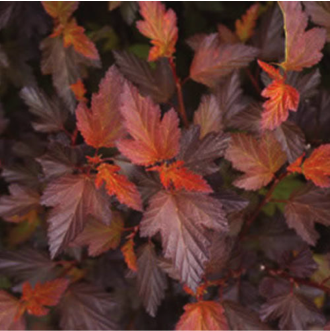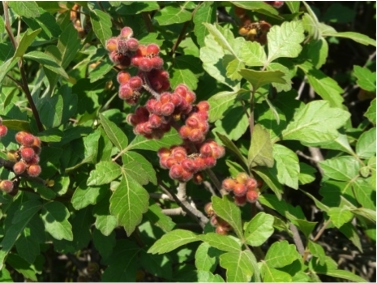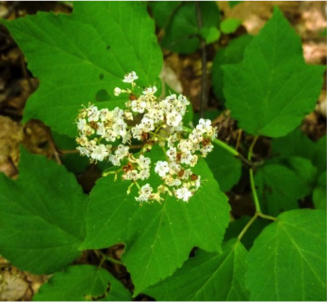

Native Replacements for Japanese Barberry
Terry Bonace
Japanese barberry is easy to grow, has pretty foliage, and is very deer resistant. As a result, it is no surprise to find that Japanese barberry is planted throughout in Beverly Shores. But the plants escape readily and grow in dense stands, crowding out our native plants. Even worse, deer ticks—carriers of Lyme disease—thrive under the dense foliage. No wonder the plant is labeled “LEAST WANTED” by the National Park Service. It is a very good idea to seek attractive native alternatives.

Ninebark (Physocarpus opulifolius) is a good substitute. The cultivars “Diabolo” and “Summer Wine” have attractive purplish foliage. “Coppertina” has a copper-orange colored foliage and “Dart’s Gold” has yellow-chartreuse foliage. Ninebark is native to the Midwestern United States and Northwest Indiana. It is hardy and relatively easy to grow. Ninebark is the host plant for the tiny but beautiful spring azure butterfly and its dense growth form provides excellent bird shelter. Ninebark’s peeling bark reveals a gamut of shades of brown and red (the source of its common name) that contributes winter interest. In spring, ninebark has spirea-like clusters of pink to white flowers. Later in summer it develops small dry bladder-like fruit that persists in the winter. Ninebark is resistant to deer browsing and will grow back quickly if browsed.

Aromatic sumac is a member of a largely tropical family of plants. Its cousins include not only the tasty cashew and mango, but also the skin-rash-inducing poison ivy and poison sumac (poison sumac is a very handsome plant. If it were not for its toxic leaves, it would be on the top of many lists for ornamental native plants). Aromatic sumac resembles a smaller, denser, bushier, glossy-leaved poison ivy. Its leaves have a fresh citrus scent when crushed (and crush it freely without fear of a bad skin reaction). The leaves turn a lovely orange and red in the autumn.

Aromatic sumac has plants with both male and female flowers and plants having only one sex or the other. In order to be sure to get berries, you need to have several plants. Aromatic sumac spreads by root suckers and usually grows 1 to 2 feet tall but can spread to a width of 8 feet. You can find this sumac growing in the very sandy soil at the garden at Reborah Plaza and also in the dunes in the both the National Lakeshore and the Indiana Dunes State Park. The plant has red, hairy berries in late summer that are attractive to birds. Its foliage hosts the caterpillars of the red banded hairstreak butterfly. An additional advantage, shared with most aromatic plants, is that aromatic sumac is very deer resistant.

Though saddled with a frightening name. chokeberry plants, either black chokeberry (Aronia melanocarpa) with black fruit, or red chokeberry (Aronia prunifolia) with red fruit, are easy to grow. Chokeberry produces pretty white flowers in the spring, attractive and edible fruit in the late summer, and beautiful red foliage in the autumn. The fruit may be an acquired taste, however, as the common name “choke” is supposed to refer to tart, bitter flavor of the berries and just shows you that if you add enough sugar, almost anything can taste good. The berries are rich in vitamin C and can be made into juice, jam and wine. The Chicago Botanic Garden recommends black chokeberry over red, as it is more attractive, spreads less aggressively, and is slightly smaller in stature. You will also find that black chokeberry is more commonly sold at nurseries. Chokeberry can grow in wet, partial shade or dry sand so it can tolerate the gamut of habitats found in Beverly Shores. It also provides cover and food for birds and wildlife. Chokeberries are considered deer resistant.

Maple-leaf viburnum (Viburnum acerifolium), also rather quaintly known as dockmackie or possomhaw, is a small shrub with somewhat maple-like three lobed leaves and a flat-topped cluster of white flowers in the spring. This viburnum is common in Northwest Indiana and can be seen easily in woods around Beverly Shores. Like other plants that grow commonly in our woods, it is quite tolerant of sandy, shady conditions. The flowers are followed by berries that change from red to purple in late summer and are eaten by birds and other wildlife. Like chokeberry, the fruit is edible but not necessarily delicious. Maple-leaf viburnum also has outstanding fall color; the leaves turn pink to purple in the autumn, making them an attractive addition to your garden. Like other viburnums, maple-leaf viburnum is also a host plant to the spring azure butterfly and is resistant to deer browsing.
As always, the Environmental Restoration Group (ERG) will be glad to help identify plants for you and make suggestions for native replacements. Don’t hesitate to contact Terry Bonace (tbonace@gmail.com), Hans Lagoni (hlagoni@comcast.net ) or Bill Schaudt (blschaudt2@gmail.com) for assistance.